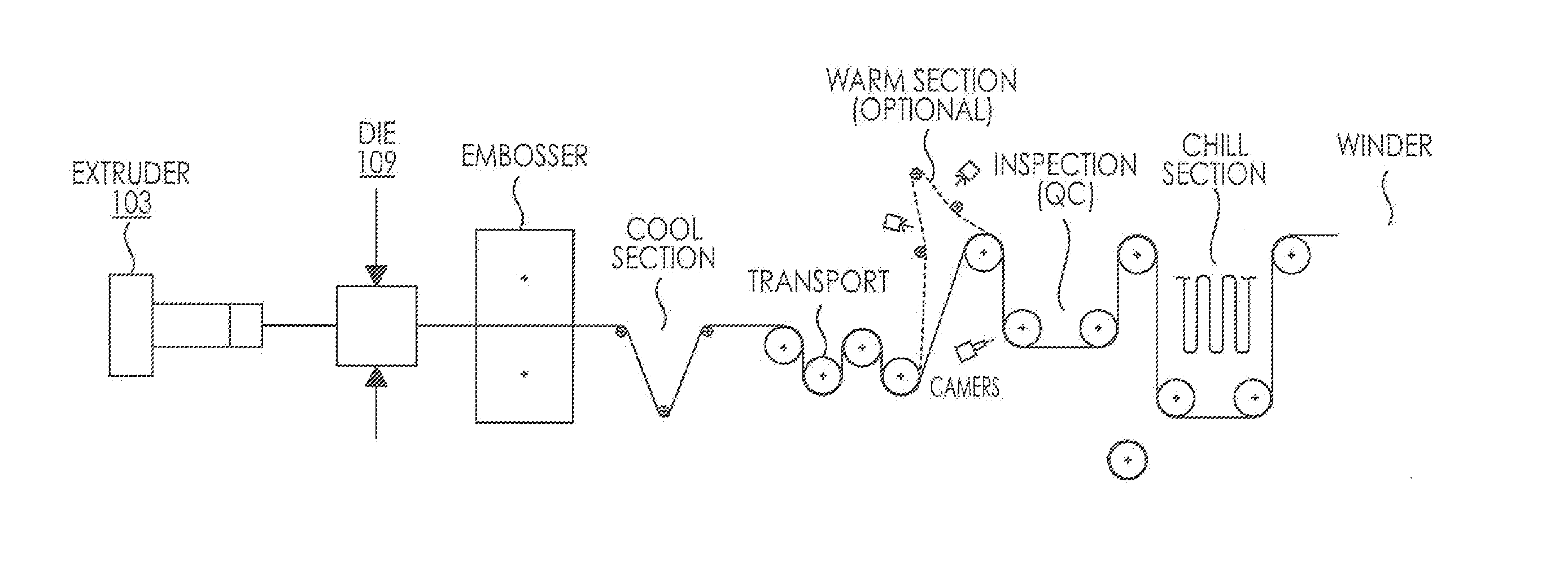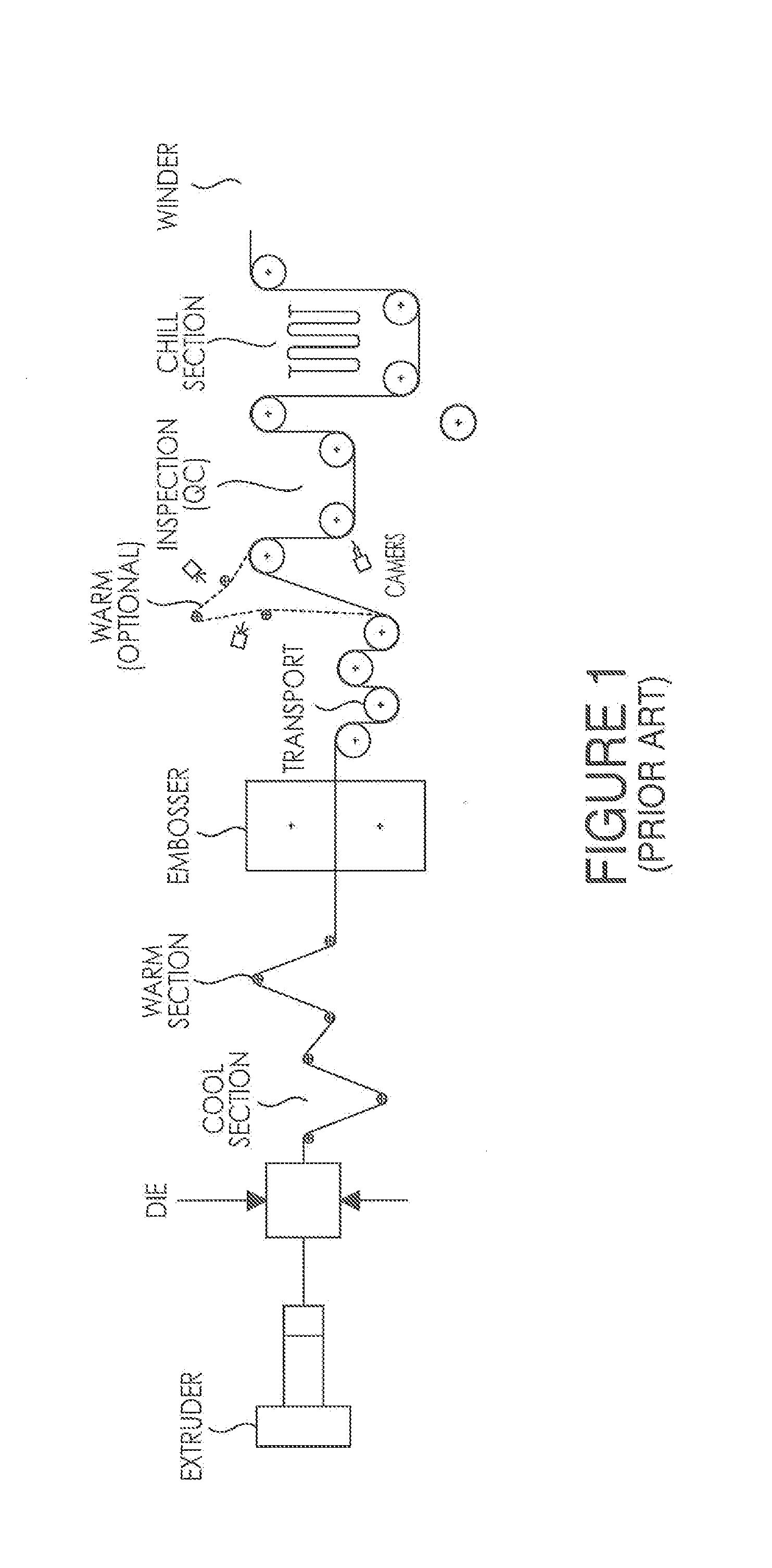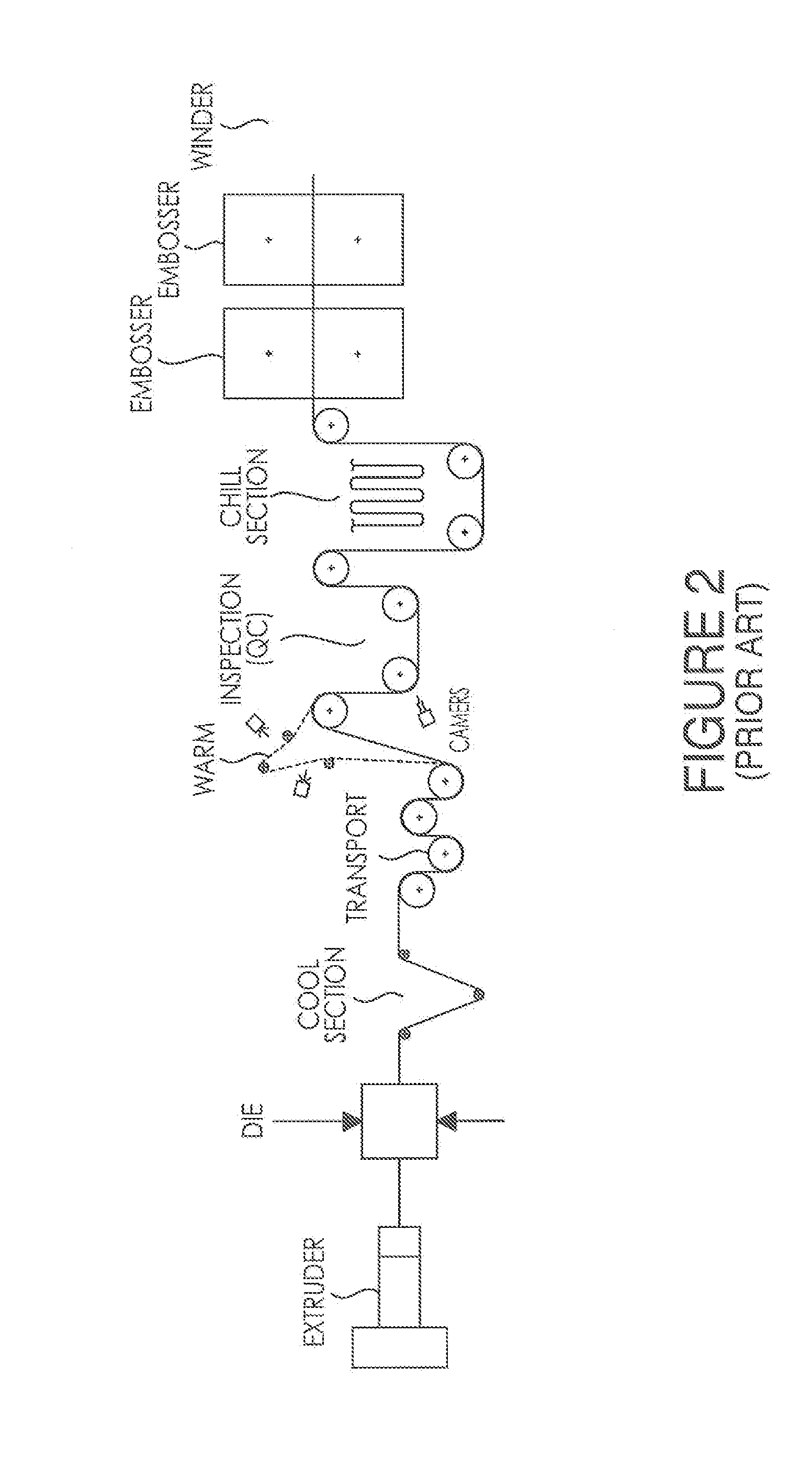Systems, methods and apparatuses for direct embossment of a polymer melt sheet
a technology of polymer melt and embossing method, applied in the field of systems, can solve the problems of blockage, difficult, if not impossible, to separate polymer interlayer sheets, and difficult to separate sheets or blanks back into individual pieces without blockag
- Summary
- Abstract
- Description
- Claims
- Application Information
AI Technical Summary
Benefits of technology
Problems solved by technology
Method used
Image
Examples
example 1
[0069]
TABLE 1EmbossedMeasurementsMeasurementsPermanenceSurfaceEmbossingof Embossingof EmbossingMeasured atRetentionRolleron Polymeron PolymerMottle100° C. for100° C. forSamplePatternSide 1Side 2(CMA)5 minutes5 minutesNE A—Rz: 14Rz: 130.2Rsm: 528Rsm: 465CP ARz: 90Rz: 56Rz: 570.39682Rsm: 249Rsm: 298Rsm: 294DP ARz: 90Rz: 64Rz: 44010097Rsm: 249Rsm: 271Rsm: 286NE B—Rz: 37Rz: 373.3Rsm: 830Rsm: 889CP BRz: 90Rz: 49Rz: 502.06986Rsm: 249Rsm: 313Rsm: 367DP BRz: 90Rz: 74Rz: 641.5101102Rsm: 249Rsm: 288Rsm: 280NE C—Rz: 49Rz: 505.2Rsm: 910Rsm: 868CP CRz: 90Rz: 57Rz: 583.05888Rsm: 249Rsm: 323Rsm: 364DP CRz: 90Rz: 74Rz: 650.7101102Rsm: 249Rsm: 285Rsm: 272
[0070]Example 1 demonstrates that the Disclosed Process consistently has better permanence and embossed surface retention (higher values) of the embossed surfaces regardless of the original surface roughness of the sheet. In this Example, “A”“B” and “C” represent test sheets with different roughness values as formed directly out of the extrusion die...
example 2
[0071]
TABLE 2EmbossedEmbossedMeasurementsSurfaceSurfaceStackEmbossingof EmbossingMeasurementsRetentionRetentionStickingRolleron Polymerof Embossing onMottle100° C. for140° C. forPeel ForceSamplePatternSide 1Polymer Side 2(CMA)5 minutes5 minutes(g / cm)NE—Rz: 13Rz: 131.00103104807Rsm: 365Rsm: 398CP XRz: 90Rz: 54Rz: 54.60724959Rsm: 249Rsm: 285Rsm: 287CP YRz: 90Rz: 52Rz: 51.60695264Rsm: 249Rsm: 292Rsm: 288CP ZRz: 90Rz: 48Rz: 47.73654970Rsm: 249Rsm: 294Rsm: 282DPRz: 90Rz: 61Rz: 54.191019023Rsm: 249Rsm: 290Rsm: 275
[0072]Table 2 depicts a comparison of a non-embossed sheet and a sheet embossed by the Disclosed Process with sheets embossed by the Conventional Processes (“X”“Y” and “Z”) for which the process variables of line speed, embossing roller temperature and force applied to the sheet by the rollers were varied in an attempt to attain the same measured embossed values as those obtained on the sheet formed by the Disclosed Process. Embossed surface retention of the samples was measured ...
example 3
[0073]
TABLE 3EmbossedSurfaceRetention140° C. for 30SampleRzminutesNE1394CP5340DP5477
[0074]Table 3 depicts the results from comparison testing at the extreme testing conditions for embossed surface retention (140° C. for thirty (30) minutes). As shown in Table 3, the embossed surface retention value for the Disclosed Process is significantly higher than that of the Conventional Process even in extreme testing conditions and closer to non-embossed (random rough) surfaces.
[0075]The improved embossed surface retention values of various polymer interlayer sheets embossed by the Disclosed Process in comparison to the Conventional Process over multiple testing conditions is graphically depicted in FIG. 7. FIG. 7 provides a line graph of comparative embossed surface retention values for multiple different samples of polymer interlayers embossed by the Disclosed Process and the Conventional Process. As can be seen in FIG. 7, no matter the sheet tested or the process variables manipulated, th...
PUM
| Property | Measurement | Unit |
|---|---|---|
| surface roughness Rz | aaaaa | aaaaa |
| temperature | aaaaa | aaaaa |
| temperature | aaaaa | aaaaa |
Abstract
Description
Claims
Application Information
 Login to View More
Login to View More - R&D
- Intellectual Property
- Life Sciences
- Materials
- Tech Scout
- Unparalleled Data Quality
- Higher Quality Content
- 60% Fewer Hallucinations
Browse by: Latest US Patents, China's latest patents, Technical Efficacy Thesaurus, Application Domain, Technology Topic, Popular Technical Reports.
© 2025 PatSnap. All rights reserved.Legal|Privacy policy|Modern Slavery Act Transparency Statement|Sitemap|About US| Contact US: help@patsnap.com



